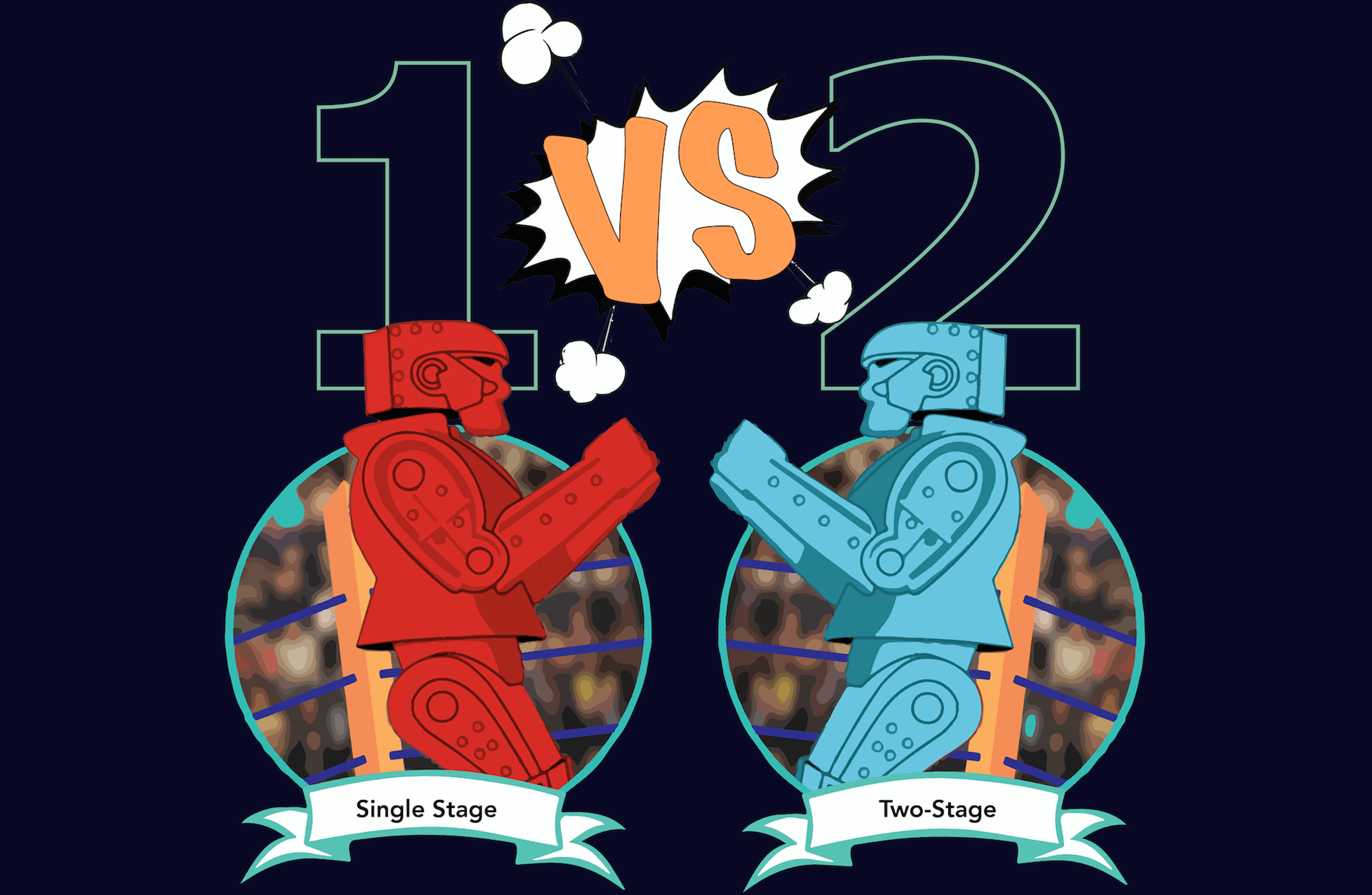Single Stage vs Two Stage
Single Stage vs Two Stage is a question we regularly face, whilst not a new method of procurement, two-stage tenders are becoming an increasingly popular choice for both contractors and customers in the construction sector.
The government’s Construction 2025 strategy suggests that customers are not achieving their full project value potential because of ineffective procurement, this is a real problem for public sector customers, especially during these challenging economic times.
Two-stage procurement provides some of the answers; increased levels of collaboration and early contractor involvement lead to opportunities to de-risk highly technical or logistically challenging projects.
With commentary from leading contractors GRAHAM and Interserve Construction Ltd, in this blog, Robbie Blackhurst discusses why customers are increasingly moving away from single-stage and traditional procurement routes to deliver better project outcomes and weigh up Single Stage vs Two Stage.
What Are The Drawbacks of Single-Stage Procurement?
It is useful when considering the benefits which arise from two-stage procurement, to first consider the drawbacks to single-stage procurement and the necessity for an alternative. During a single-stage procurement process, the customer will traditionally set out their project requirements and several contractors will compete for the contract based on price.
This process generally doesn’t serve either party well. Separating the design development and construction process exposes both the contractor and the customer to high levels of risk. There is often significant expense and effort expended by the bidding contractor (with only a small chance of a contract award), and a high probability that the lowest price is based on under-developed and incomplete design information, leaving scope for dispute at a later date.
If procuring via a single-stage route, it is important that the customer can say confidently that the design is sufficiently developed and robust, and realistic evaluations of issues such as budget, project delivery timeframes and key risks have been considered before tendering. Of course, many single-stage tender processes proceed without these issues having received due attention, which is where much of the risk lies!
How Does The Two Stage Approach Differ?
In the first stage of a two-stage process, the customer provides an outline project design and contractors then compete for preferred contractor status. This involves submitting a price for assisting the customer in designing the building, together with a schedule of rates that will be used to form a fixed price for the complete works during stage two.
This is a much shorter, less labour-intensive process for the bidding contractors and only the preferred bidder is taken forward to the next stage. The chosen preferred contractor then assists in the design and development of the construction issue drawings, helps to develop a workable method statement and develops relationships with the supply chain to gather critical information.
It is only once these issues are resolved during stage one of the process that the contractor enters into a detailed contract negotiation with the customer to agree on the final price, the contract conditions and the agreed programme.
The advantages of this approach for the customer are significant. The customer benefits from the technical expertise of the contractor at a much earlier stage and the contractor has the opportunity to engage with the supply chain to value engineer the project, contribute towards the final design and develop innovative solutions which can improve buildability and programme efficiency.
By sharing their expertise, engaging with suppliers clearly and transparently, and working collaboratively as part of a seamless team, the contractor can look to reduce overall delivery costs and set realistic timescales.
Keith Hayes, National Framework Director for GRAHAM, credits two-stage procurement as a way to bring cost and programme certainty for their customers: “At GRAHAM, we fully endorse two-stage tendering, this procurement route has delivered real value for our Clients and ourselves. The two-stage procurement process promotes collaborative working and significantly de-risks the project for all stakeholders, providing greater cost and programme certainty as the design has been fully developed collaboratively between all parties. Critically, this incorporates innovation, MMC opportunities and buildability advice from us, as the contractor, and our supply chain.”
Sharing the risk and the reward
Due to the high levels of collaboration and resources in the initial stages, the final pricing exercise completed in the second stage should be more realistic. The preferred contractor has an in-depth understanding of the project and is working from a solid foundation of design detail, meaning the risks can be jointly explored.
This type of collaborative approach can lead to a ‘pain/gain’ agreement seeing all parties benefit from a successful project result. Often this results in highly successful and profitable schemes. As the contract progresses, the ‘open book’ approach means that costs can be carefully controlled and reviewed at predetermined gateways to ensure ongoing affordability and to prevent any negative surprises for both the customer and the contractor.
This type of cost control is incredibly important to customers with challenging budgets, helping them to demonstrate that the maximum value is being achieved at each stage.
Phil Shaw, Divisional Director of Interserve Construction maintains that customers can achieve the best price with a two-stage approach: “Early contractor involvement is essential when dealing with complex issues that require solutions such as phasing, methodology and buildability at a much earlier stage. This ensures the price is developed taking into consideration the client’s specific constraints. Having this expertise involved in the second stage allows the right people with the right skills to manage and drive the pre-construction design. Constant review of costs allows the contractor to design to cost and not cost a design, bringing more certainty to meeting the client’s affordability targets. Competitive tension can still be maintained through an open book process to ensure the client gets the best solution at the right price.”
Used correctly, two-stage tendering is a powerful tool to achieve customer’s ambitions of efficiency, value and a better end product, essential in today’s challenging market.
How to get Two-Stage Procurement Right
Despite the many great examples in the industry of how two-stage procurement drives success, some risks will naturally remain. Many of these risks for the customer revolve around the financial stability and capability of the chosen contractor with whom the customer enters into detailed negotiations. Ensuring appropriate due diligence is completed on contractors during the first stage of the process helps to alleviate the risk.
Critical to a successful two-stage process is the ability to get as much detail as possible into the pre-construction services agreement, such as dates and durations, cost targets, realistic design and procurement programme, engagement of the supply chain and pre-construction activities. This can help to control any variables which have the potential to lead to price escalation and delay. Ensuring a clear plan and mutual understanding of the teams’ roles and responsibilities can help smooth delivery and provide conflict-free outcomes.
GRAHAM’s Keith Hayes continues; “In the midst of persistent challenges for the wider construction industry, two-stage tendering is helping us to deliver better outcomes for our clients. Over the last four years, we have had a 100% record in successfully converting two-stage projects through to completion. In these challenging times for construction, our proven delivery in the second stage has made our clients’ lives easier and helped to smooth the path throughout the entire journey – from pre-construction, design, construction through to handover. In turn, we’ve delivered benefits beyond the brief. Consistently, we’ve achieved certainty for our partners who span a broad range of sectors including Healthcare, Defence, and the wider Public Sector alongside commercial, residential and student residential markets.”
Two-stage tenders work best when all parties trust one another and work together. Frameworks such as the Procure Partnerships Framework, provide public sector customers with pre-approved contractors with a proven track record. A framework also provides various fully compliant procurement options, allowing the customer to choose which route is right for their project under the guidance and support of a team of specialist procurement experts.
This additional layer of reassurance and support helps to empower customers to move away from risky ‘lowest price’ bidding and towards a more collaborative process, where the whole team is focused on the best value.
Want to learn more? Check out the Procure Partnerships Framework Podcast were we speak to Jess Munn, Framework and Partnership Manager for Speller Metcalfe. We discuss Call Off Methods, Single Stage vs Two Stage, the pros and cons of them and a contractors perspective of the benefits here.



